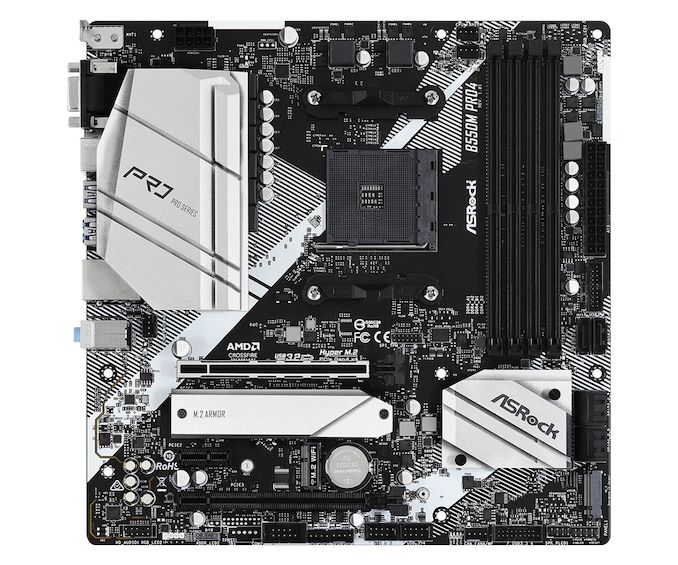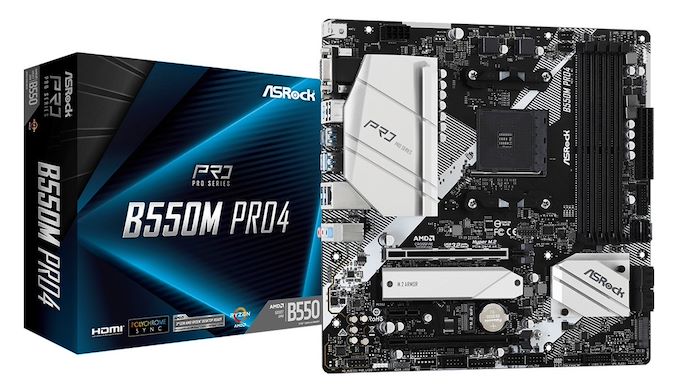The AMD B550 Motherboard Overview: ASUS, GIGABYTE, MSI, ASRock, and Others
by Dr. Ian Cutress & Gavin Bonshor on June 16, 2020 11:00 AM ESTASRock B550M Pro4
Even though there is a mATX version of the Pro4, the two boards are not variants of each other. The B550M Pro4 has a different layout of where the boards are by comparison, as well as a different arrangement on the rear panel.
There is still the 75% rear panel cover over the top of the controllers from the back panel, also covering the power delivery (6-phase) this time, and the chipset heatsink / M.2 heatsinks are not connected either. The CPU takes power from a single 8-pin, and the socket has access to three 4-pin fan headers within reasonable distance.
To the right of the socket are four memory slots, all using single side latches as to not interfere when large bulky graphics cards are used. On the right hand side of the board, at the top we have an RGB header, then a 24-pin ATX connector, then a USB 3.0 header, two vertical SATA ports, four regular SATA ports, and then a chipset based PCIe 3.0 x2 M.2 slot.
For the PCIe area, the top slot is a PCIe 4.0 x16 slot with additional reinforcement, and that sits just above the PCIe 4.0 x4 M.2 slot for storage, which has its own heatsink (but isn’t connected to the chipset heatsink). The board also has a PCIe 3.0 x4 full-length slot at the bottom, between which is a M.2 Wi-Fi connector for anyone to add in their own Wi-Fi card.
Along the bottom of the motherboard is the video output header, two RGB LED headers, a COM port header, three more 4-pin fan headers, two USB 2.0 headers, another USB 3.0 header, and the front panel outputs. On the far left is the audio solution, which uses an ALC1200 with PCB separation and some filter caps.
On the rear panel from left to right is a spot for Wi-Fi antenna, an analog D-Sub video output, a HDMI port, a DisplayPort, two USB 2.0 ports, a combination P/2 port, a Type-A USB 3.2 Gen 2 port, a Type-C USB 3.2 Gen 2 port, four USB 3.2 Gen 1 ports, a Realtek RTL8111H gigabit Ethernet port, and the audio jacks.













101 Comments
View All Comments
althaz - Wednesday, June 17, 2020 - link
Hmm, these seem mostly...pointless? More expensive than B450 by a lot, barely cheaper than the superior X570 boards (which have more PCIe lanes, more USB ports, etc)...these really need to be $50 cheaper across the (mother)board to make sense, IMO.sing_electric - Thursday, June 18, 2020 - link
It is interesting comparing similar X570 and B550 models within the same brand (or subbrand like Asus ROG or Gigabyte Aorus). It really seems like pricing is VERY close between them.Of course, if the VRMs are comparable, then for 90%+ of users, a X570 and a B550 are basically equivalent. In some cases it's almost like you're giving the user a choice between a newer B550 board with WiFi 6 and an older X570 board with AX but more USB ports or something, for within a few bucks of the same price (if you can find them at MSRP and in stock, which really has been an issue of late.)
jrbales@outlook.com - Wednesday, June 17, 2020 - link
I was looking at the boards on morning of Jun 16th. Very few B550 boards in stock (not too unusual so soon to release) and prices were high, in the range there just a few months ago I could have bought an X570 board. However, X570s were mostly out of stock everywhere I looked, and those in stick were generally pushing $300 USD or more. I suspect either manufacturing has not completely ramped up after COVID-19 in Asia, or that there is still a shipping back-load via ocean freight bearing ships between Asia and North America. Maybe if we ever see a return to a semblance.nce of normal, prices might lower and parts return to stock,
romrunning - Wednesday, June 17, 2020 - link
Shipping is main culprit here - big problem, including extra time spent in customs at ports (like LA in the US).sing_electric - Thursday, June 18, 2020 - link
Right - In February I picked up an X570 board for ~$30 under MSRP, so equivalent B550 board (same OEM, same 'line') would actually be a few bucks more... but adds a Thunderbolt header, WiFi 6 and 2.5 gig Ethernet (in exchange for PCIe lanes/slots and USB ports, and a 2nd m.2 connector). In the end, I think the X570 was a perfectly good choice on sale.willis936 - Wednesday, June 17, 2020 - link
I love that summary table. I wish it had an entry for “8 or more USB-A ports”. I actively use 15 on my desktop. The fewer PCIe cards and hubs needed, the better imo.GNUminex_l_cowsay - Wednesday, June 17, 2020 - link
Thanks for giving detailed and, hopefully, correct information about the PCIe configurations on these boards. Unfortunately many of the motherboard manufacturers don't give that information, make the information hard to find, give wrong information, or some combination of the above with regards to PCIe configuration.Out of curiosity, what happens when you put a pcie 3.0 x4 ssd in an x2 slot when the ssd's maximum read and write rates don't fully saturate x4? Is it just limited to the ~2GB/s bandwidth of the slot or does the ssd do something worse?
Lucky Stripes 99 - Wednesday, June 17, 2020 - link
Yeah, it will transfer just a bit under 2 GB/s due to overhead. I had this same issue with my H97 board and my Samsung 970, so I opted to purchase a cheap M.2 PCIe 3.0x4 card. HD Tune showed an improvement, but not by much to notice much real world difference.Allan_Hundeboll - Wednesday, June 17, 2020 - link
What about the Gigabyte 550M s2h?It's 12$ cheaper than the ds3h, so I would like to know what gigabyte did to lower the cost.
xenol - Thursday, June 18, 2020 - link
A complaint I had in previous AMD boards was how prevalent VGA ports were. I'm glad to see they're not so prevalent this time around.